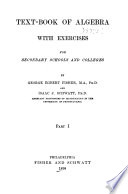 To reduce fractions to their lowest terms. A fraction is in its lowest terms when its numerator and denominator are prime to each other; that is, when both terms have no common divisor. To reduce fractions to their lowest terms. A fraction is in its lowest terms when its numerator and denominator are prime to each other; that is, when both terms have no common divisor.  Advanced Algebra - Page 94by Arthur Schultze - 1905 - 562 pagesFull view Advanced Algebra - Page 94by Arthur Schultze - 1905 - 562 pagesFull view - About this book
 | George Egbert Fisher, Isaac Joachim Schwatt - Algebra - 1898 - 714 pages
...can be proved in a similar way. Reduction of Fractions to Lowest Terms. 13. A fraction is said to be in its lowest terms when its numerator and denominator have no common integral factor. If the numerator and denominator of a given fraction have common factors, the fraction... | |
 | William J. Milne - Algebra - 1899 - 172 pages
...the terms of a fraction, without changing the value of the fraction ? 114. A fraction is expressed in its Lowest Terms when its numerator and denominator have no common divisor. 115. PRINCIPLE. Multiplying or dividing both terms of a fraction by the same quantity does... | |
 | George Egbert Fisher, Isaac Joachim Schwatt - 1899 - 506 pages
...be proved in a similar way. Reduction of Fractions to Lowest Terms. 11. A fraction is said f to be in its lowest terms when its numerator and denominator have no common integral factor. F„ 2 *-! Eg, £ 6 Ex. 1. Eeduce й 8 , „ to its lowest terms. O Oí U С The factor... | |
 | George Egbert Fisher, Isaac Joachim Schwatt - Algebra - 1900 - 206 pages
...from its denominator ; » +J -IReduction of Fractions to Lowest Terms. 7. A fraction is said to be in its lowest terms when its numerator and denominator have no common integral factor. Eg., | J^i. о ar + 1 8. Reduce f to lowest terms. Let the value of £ be denoted... | |
 | George Egbert Fisher - 1900 - 444 pages
...- a ~(ba)(b- c) (a - c) a - x Reduction oí Fractions to Lowest Terms. 8. A fraction is said to be in its lowest terms when its numerator and denominator have no common integral factor. 3' 9. The value of a fraction is not changed if both numerator and denominator be... | |
 | James Morford Taylor - Algebra - 1900 - 504 pages
...С + СЖ _ (С + Сар-i- С _ 1 +Х с + су~(с + су)+с~ l +у 174. A fraction is said to be in its lowest terms when its numerator and denominator have no common factor. 175. To reduce a fraction to its lowest terms, Divide its numerator and denominator by all... | |
 | John Appley Ferrell - History - 1901 - 448 pages
...209ths. 9. H to 708ths. 5. to 390ths. ¿0. l& to 8181sts. 36. Reducing Fractions to LoA^est Terms. — A fraction is in its lowest terms, when its numerator and denominator are prime to each other. Divide both numerator and denominator by their GCD, or reject all factors... | |
 | George Egbert Fisher - 1901 - 622 pages
...a (5 — a) (b — c) (a — c) Reduction oi Fractions to Lowest Terms. 8. A fraction is said to be in its lowest terms when its numerator and denominator have no common integral factor. Tfa 2 Z-1 Eg, g, 9. TJie value of a fraction is not changed if both numerator and... | |
 | George Egbert Fisher, Isaac Joachim Schwatt - Algebra - 1901 - 664 pages
...can be proved in a similar way. Reduction of Fractions to Lowest Terms. 11. A fraction is said to be in its lowest terms when its numerator and denominator have no common integral factor. Ex. i. Eeduce - to its lowest terms. 8 сгггс6 The factor 2 a2&V is the HGF of... | |
 | International Correspondence Schools - Sheet-metal work - 1901 - 578 pages
...fraction, and multiply both terms of the given fraction by the quotient. 28. A fraction is said to be in its lowest terms when its numerator and denominator have no common factor. 29. In ordinary cases, a fraction can be reduced to its lowest terms by the following rule:... | |
| |